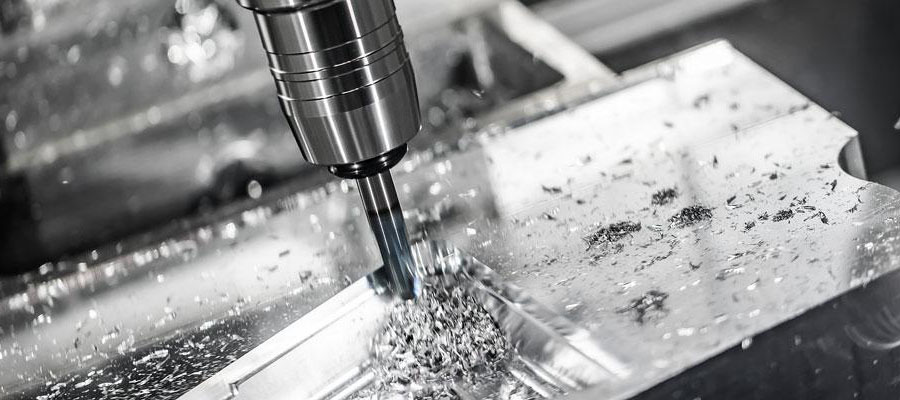Because different metals have different materials, the CNC milling methods cannot be exactly the same. This article briefly introduces different milling methods and suggestions for different materials.
Steel Milling
The machinability of steel varies with alloying elements, heat treatment and manufacturing processes (forging, casting, etc.). When processing softer low-carbon steel, the main problem is the formation of built-up edge and the formation of burrs on the workpiece. In order to avoid chipping when machining harder steel, the relative position of the milling cutter and the workpiece will become more important.
Suggest:
When milling steel parts, optimize the position of the milling cutter to avoid thick chips when the tool is retracted. Make sure to consider dry cutting without the use of cutting fluid, especially in the rough machining process.

Stainless Steel Milling
Stainless steel can be classified into ferritic/martensitic stainless steel, austenitic stainless steel and duplex (austenitic/ferritic) stainless steel. Each type has its own milling recommendations.
1) Milling Of Ferritic/Martensitic Stainless Steel
Material classification: P5.x
The machinability of ferritic stainless steel is similar to that of low-alloy steel, so steel milling recommendations can be used.
Martensitic stainless steel has higher work hardening performance and requires very high cutting force when cutting. Use the correct tool path and arc cutting method to obtain the best results, and use a higher cutting speed Vc to overcome the work hardening effect. Higher cutting speeds, tougher materials and enhanced cutting edges can ensure higher safety.
2) Milling Of Austenitic And Duplex Stainless Steel
Material classification: M1.x, M2.x and M3.x
The main wear criteria for milling austenitic stainless steel and duplex stainless steel are cutting edge chipping due to hot cracking, groove wear and built-up edge/bonding. For parts, burr formation and surface quality issues are the main issues.
Suggestions For Rough Machining:
Use high cutting speed (Vc=150-250m/min) to avoid built-up edge
Dry cutting without using cutting fluid to minimize hot cracking problems.
Suggestions For Finishing:
1) In order to improve the surface quality, sometimes it is necessary to use cutting fluid or preferably oil mist lubrication/minimum lubrication. There are fewer hot cracking problems during finishing, because the heat generated in the cutting area is lower.
2) When using cermet materials, a sufficiently good surface quality can be obtained without using cutting fluid.
3) If the feed fz is too low, the cutting edge may cut in the deformation hardened zone and cause more serious wear of the insert.

Non-ferrous Metal Material Milling
Non-ferrous metal materials include not only aluminum alloys, but also magnesium, copper, and zinc-based alloys. Machinability varies mainly due to the difference in silicon content. Hypoeutectic aluminum-silicon alloy is the most common type, with a silicon content of less than 13%.
Material classification: N1.1-3
The main wear criterion is built-up edge/bonding on the cutting edge, which leads to burr formation and surface quality problems. In order to avoid leaving scratches on the surface of the part, good chip formation and chip removal are essential.
Suggest:
1) The use of PCD tipped inserts with sharp polished cutting edges can ensure good chip breaking ability and prevent build-up edge.
2) Choose a positive rake insert geometry with sharp cutting edges.
3) Unlike most other milling applications, cutting fluid should always be used when machining aluminum alloys to avoid material sticking to the cutting edge of the insert and improve the surface quality.
Silicon content <8%: Use cutting fluid with a concentration of 5%
Silicon content <8-12%: use cutting fluid with a concentration of 10%
Silicon content> 12%: Use a cutting fluid with a concentration of 15%
4) Higher cutting speeds generally improve performance without negatively affecting tool life.
5) The recommended value of hex is 0.10-0.20 mm (0.0039-0.0079 inch). Too small a value will cause burrs to form
6) Due to the high table feed, a machine tool with “pre-reading” function should be used to avoid dimensional errors.
7) Tool life is always limited by burr formation or surface quality of parts. Blade wear is difficult to use as a tool life criterion.
Hardened Steel Milling
This group contains quenched and tempered steels with hardness greater than 45-65HRC. Typical parts for milling include stamping dies, plastic dies, forging dies, and die-casting dies. Blade abrasive/flank wear and workpiece chipping are the main problems.
Suggest:
1) Use a positive rake insert geometry with sharp cutting edges. This will reduce the cutting force and produce a smoother cutting action.
2) Dry cutting, avoid using cutting fluid.
3) Cycloid milling is an appropriate method, which can achieve high table feed and low cutting force at the same time, so that the cutting edge and workpiece can be kept at low temperature, which is beneficial to productivity, tool life and part tolerances .
4) In face milling, a light cutting strategy should also be adopted, that is, a small depth of cut ae and ap should be kept at the same time. Use ultra-dense-tooth milling cutters and relatively high cutting speeds.


